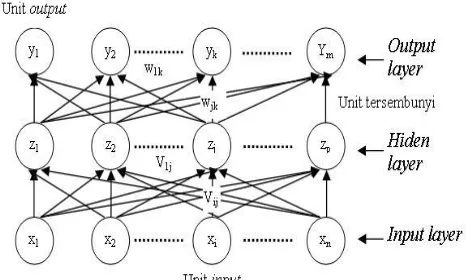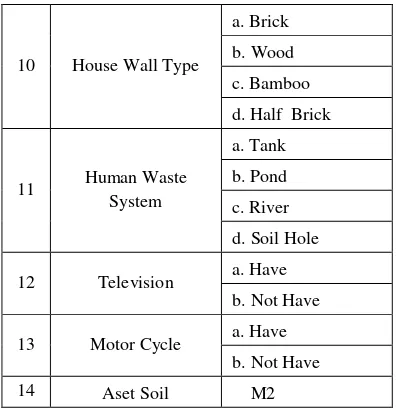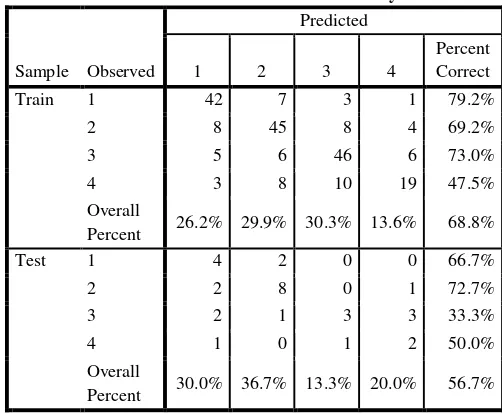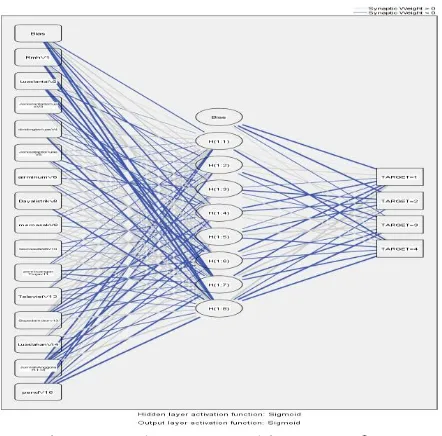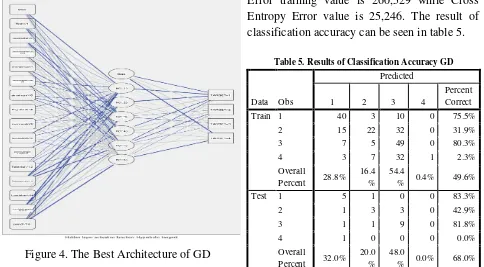Online version is available at : http://jurnal.buddhidharma.ac.id/index.php/te
JURNAL TECH-E
| 2581-1916 (Online)| 2598-7585 (Print) |
Artikel
Neural Network Modeling for Family Welfare
Classification
Sri Redjeki1
1Teknik Informatika,STMIK AKAKOM,Yogyakarta,Indonesia
SUBMISSION TRACK A B S T R A C T
Recieved: Feb 28, 2018 Final Revision: March 03, 2018 Available Online: May 15, 2018
Welfare in general can be defined as the level of a person's ability to meet their basic needs in the form of clothing, food, boards, education, and health. Welfare can be assessed in terms of family welfare. This study aims to perform analysis of artificial neural network modeling backpropagation method. The model will compare the optimization algorithm of artificial neural network results.
The data used are 251 data of pre prosperous family in Banguntapan District, Bantul Regency. There are 16 input variables with 14 variables from BPS and 2 additional variables. There is one variable that has constant data so that this variable is not used in artificial neural network model analysis. There is a hidden layer with a number of dynamic neurons. Output layer there are 4 neurons which is the family welfare category. Data is processed using Matlab and SPSS. The system results show that the best accuracy for training is 68% of the Scale Conjugate Gradient algorithm while for best test results it is 68.8% of the Gradient Descent algorithm.
KEYWORD
Neural Netwok, Classification, Welfare.
KORESPONDENSI
Phone: 081393108866 E-mail: [email protected]
PENDAHULUAN
Family welfare is the creation of a harmonious state and the fulfillment of physical and social needs for family members, without experiencing serious obstacles in the family environment, and in the face of family problems will be easy to be tackled together by family members, so the standard family life can be realized. Prosperous family is a model generated from the family welfare effort (Soembodo, 2008).
Law Number 10 of 1992, a prosperous family is a family formed on the basis of legitimate marriages, able to meet the material and spiritual needs of a decent, devoted to God Almighty, has a harmonious and balanced
relationship between members and between families with society and the environment.
with a high number of poor people so that the level of family welfare is still considered low. The high number of poor people makes the ideals of the state to prosper the community is further realized even though the government continues to cope with poverty. Many policies have been issued by the government to overcome the problem of poverty, ranging from the provision of community consumptive assistance and productive assistance but the policy on its implementation has not been able to overcome the problem of poverty.
Policies that have been done often just cause new problems such as the existence of poor people when the distribution of BLT suffered injuries, fainted even to death because of jostling waiting for distribution. This kind of phenomenon shows the state has failed to perform its function to improve the people's welfare (Meniarta, et al, 2009).
Poverty and income inequality is still a homework for Yogyakarta Special Region Government (DIY), this is because until now, the poverty rate in DIY reaches 13.1% or the highest in Java Island. Besides having the highest poverty rate in Java, DIY also has the highest income inequality nationally. The gap between rich and poor in DIY is highest at 0.43 compared to the national ratio of 0.3. (daerah.sindonews.com/2-8-2017).
Currently the development of technology that leads to machine learning is expected to help detect the potential level of family welfare in a region. Artificial neural network one of the existing methods in machine learning with soft computing approach is very reliable to perform computing in parallel by learning from the patterns taught. The softcomputing approach is widely used for problem solving including one for prediction due to the ability to adapt (self organizing). One of the methods on softcomputing is very good for predicting artificial neural network (artificial neural network). Neural networks are computational
models that work like biological nervous systems when in contact with the outside world.
Artificial Neural Network
Artificial Neural Network (ANN) is one of the artificial representations of the human brain that always tries to simulate the learning process in the human brain. The term artificial is used because the artificial neural network is implemented by using a computer program capable of completing a number of calculation processes during the learning process (Schalkoff, 1992).
The Artificial Neural Network Learning Algorithm has a major advantage, namely the "learning" ability of the given example. Backpropagation is a supervised learning algorithm that uses a weight adjustment pattern to achieve a minimum error value for the output of real predicted outcomes (Ripley, 1996). Figure 1 shows the ANN architecture with backpropagation algorithm.
Figure 1. Neural Network Architecture
Backpropagation
calculate the error gradient of the units on the previous screen (Limin Fu, 1994).
The learning algorithm for networks with a hidden screen (with bipolar sigmoid activation function) is as follows:
a. Initialize all weights with small random numbers.
b. If the termination conditions have not been met, take steps 3-9.
c. For each pair of learning data, perform steps 4-9.
Phase I: Forward Chaining
Each input unit receives a signal and passes it
2. Compute all outputs in output layer unit yk (k = 1,2,…,m) :
Phase II : Backward
3. Calculate factor δ output unit based on error in each output unit yk (k = 1,2, ..., m):
𝛿𝑘= (𝑡𝑘− 𝑦𝑘)𝑓′= (𝑡𝑘− 𝑦𝑘)(1 + 𝑦𝑘)(1 − 𝑦2 𝑘)
δk is the unit of error to be used in the screen weights underneath.
4. Calculate the change rate of wkj weights with learning rate α:
∆𝑤𝑘𝑗= 𝛼𝛿𝑘𝑧𝑗 ; k = 1,2,…,m ; j =
0,1,…,p
5. Calculate factor δ hidden units based on errors in each hidden unit zj (j = 1,2,3, ..., p):
7. Calculate the rate of change of weight vji with learning rate α:
∆𝑣𝑗𝑖= 𝛼𝛿𝑗𝑥𝑖; j = 1,2,…,p ; i = 0,1,…,n
Phase III : Update weight
8. Calculate all weight changes.
The weight change of the line leading to the output unit:
𝑤𝑘𝑗(𝑛𝑒𝑤) = 𝑤𝑘𝑗(𝑜𝑙𝑑) + ∆𝑤𝑘𝑗
(k=1,2,…,m ; j=0,1,…,p)
9. Line weight changes leading to hidden units:
𝑣𝑗𝑖(𝑛𝑒𝑤) = 𝑣𝑗𝑖(𝑜𝑙𝑑) + ∆𝑣𝑗𝑖
(j=1,2,…,p ; i=0,1,…,n)
Familly Welfare Level
Definition of welfare according to Indonesian dictionary derived from the word prosperous that has the meaning of safe, sentosa, prosperous, and safe (apart from all kinds of disorders, difficulties, and so on). The word prosperity contains the meaning of sanskrit "catera" which means umbrella. Catera in the welfare context means a prosperous person who is free from poverty, folly, fear, or anxiety, so that life is safe and secure, both inward and inner (Purwana, 2014).
Family welfare is the creation of a harmonious state and the fulfillment of physical and social needs for family members, without experiencing serious obstacles in the family environment, and in the face of family problems will be easy to be tackled together by family members, so the standard family life can be realized. Family welfare is a condition that must be created by the family in forming a prosperous family (Soembodo, 2006).
METHODOLOGY
Samples of data taken are family welfare data that exist in one District of Bantul with 14 indicator from BPS. The family welfare variable used in this study is based on the provisions of BPS shown in table 1.
Table 1. Familly Welfare Indicators
NO Variable name Sub Variable
1 Status of Recidence
a. Self Owned education head of family. The data used in this research are 251 family data in Banguntapan District, Bantul Regency. Data is divided for training data and data testing. Data processing is done using Matlab and SPSS. This study uses software development methods consisting of the following stages:
1. Problem Statement
This stage includes a literature study by studying several textbooks, journals, and other scientific papers that support some research on family welfare and methods existing in artificial neural networks. Further detection results will be used to help predict the number of pre prosperous families.
This data will assist decision makers in managing poverty reduction programs. The data used as many as 251 data which is the aggregate data of pre prosperous family in the District of Banguntapan, Bantul Regency. Data obtained from SKPD BKKPPKB that handle poverty data.
2. Design System
process, Artificial Neural Network architecture (ANN) network architecture based on artificial neural network optimization algorithm.
a) Research location
The research was conducted at Banguntapan District in Bantul District. The reason to use the data of Sub-district of Banguntapan because of the District in Bantul Regency has the highest number of poor people.
b) Data collection
Samples of data taken are family welfare data, especially pre-prosperous family group as much as 251 data. The data will be divided into 2 groups ie data for training and data for testing. Data obtained from SKPD BKKPPKB Bantul District.
c) Training process.
In addition to the input data input pair, there will be a training process, some of the things required in the ANN training process include: 1. Data is divided into data that will be used for training as much as 80-90% and for training as much as 10-20%
2. Variables used in this study is divided into several parts, namely input variables and output variables. The input variables used in this study were 16 variables consisting of 14 indicators based on indicators from BPS and 2 additional indicators. As for the dependent variable is the family welfare status consisting of 4 groups or categories.
3. The determination of neural network architecture (ANN). To get maximum prediction result during practice required good ANN architecture. In this research will perform the best architecture test by using Scale Conjugate optimization algorithm.
Result dan Discussion
The data used in this study as many as 251 pre-prosperous family data in the District Banguntapan Bantul regency. The data obtained is aggregate data from SKPD BKKPPKB identification result. In this research will show the result of comparison of model optimization that is Scale Conjugate Gradient and Gradient Descent.
a. Scale Conjugate Gradien (SCG)
One of the existing optimization models on artificial neural networks is the Scale Conjugate Gradient. In this section will be seen the maximum value of system architecture of this model. The architecture obtained from several experiments and resulted in the maximum classification value in this study is shown in
Figure 2.
Tabel 3. Results of Classification Accuracy SCG
Figure 2. The Best Architecture of SCG
From the simulation of several experiments for the above data obtained the best ANN architecture seen in Figure 2. The input layer there are 16 neurons and hidden layer there are 8 neurons. While at the output layer there are 4 neurons which is a prosperous family category. The number of neurons in the hidden layer is generated randomly by the system as many as 8 neurons.
To get the best architecture is done experiment 4 times by doing the parameter value of artificial neural network. The result of comparison of system experiment can be seen in table 2.
Table 2. Result of Comparasion System SCG
No
Sum of Data SSE
Sum of Neuro
n
Accuracy
Lamdha Train
% Test
%
Train %
Test %
1 87,6 12,4 60,92 8 60,5 54,8 0,0000005
2 88 12 52,92 8 68,8 56,7 0,0000001
3 88,8 11,2 60,23 8 62,3 53,6
0,0000000 1
4 89,2 10,8 65,28 8 57,6 63,0 0,0000009
The comparison result shown by table 2 illustrates that the artificial neural network system will give good result if the amount of training data used is 88% and the data testing is 12% with lamda value of 0.00000001, this reason is because Sum of Square Error the
smallest of the other experiments. Accuracy of training shows the greatest value of existing data is 68.8%. Details of SPSS system classification results in this experiment can be seen in table 3.
The ROC graph (Receiver Operating Characteristic) in Figure 3 is used to see predicted results, if the graph is above the normal line, the result is high sensitivity.
Figure 1. ROC Graphic of SCG Algorithm
b. Gradient Descent (GD)
Figure 4. The Best Architecture of GD
The number of artificial neural network architecture inputs on Scale Conjugate Gradient and Gradient Descent are the same ie there are 16 neurons. To get the best architecture is done experiment 4 times by doing the parameter value of artificial neural network. The result of comparison of system experiment can be seen in table 4.
Table 4.Result of Comparasion System GD
The comparison result shown by table 4 illustrates that the artificial neural network system will give good result if the amount of training data used is 90% and the data testing is 10% with the alpha and momentum value is 0.9 with the best Testing accuracy value is 68 % and Training accuracy 49.6%. Cross Entropy
Error training value is 260,529 while Cross Entropy Error value is 25,246. The result of classification accuracy can be seen in table 5.
Table 5. Results of Classification Accuracy GD
Data Obs normal line then the result of high sensitivity.
best Testing accuracy produced by Gradient Descent algorithm that is equal to 68%.
Conclussion
The results of the explanation that existed in the previous chapter then it can be drawn conclusions about the results of research include:
a. Backpropagation algorithms can be used to classify family welfare
b. The neural network architecture optimization algorithm Scale Conjugate Gradient has better training accuracy result than Gradient Descent. c. Variables that have the same value will affect the results of classification of artificial neural networks.
d. Accuracy value of training generated equal to 68% and accuracy of testing value equal to 68,8%.
REFERENCE
BKKBN,2006, Kependudukan dan Pembangunan, http://www.bkkbn.go.id/news-detail.php?nid790, Date 14 Februari 2013.
Dewi, Candra, and M. Muslikh, Perbandingan Akurasi Backpropagation Neural Network dan ANFIS Untuk Memprediksi Cuaca,
LiMin Fu, (1994), “Neural Network in Computer Intelligence”, McGraw-Hill Inc., Florida. Meniarta, et al, 2009. Dinamika Sistem Kesejahteraan dan Modal Sosial di Masyarakat
Banjar Pakraman-Bali dalam Jurnal Ilmu Sosial dan Ilmu Politik, Vol. 13, Nomor 2, November 2009.
Pernia, Ernesto M dan M.G. Quibra, 1999, Poverty in Developing Countries, Handbook of Regional and Urban Economics Vol 3. Amsterdam: Elseiver.
Peraturan Bupati Bantul Nomor 21A Tahun 2007
Purwana, Agung Eko. 2014. Kesejahteraan dalam Perspektif Ekonomi Islam. Ponorogo: STAIN.
Redjeki, S., Anggoro, P., Guntara, M. dan Cokro, R., 2016, The Integration System Of Classification, Monitoring and Mapping For Poor Families Using INA-SDI Service, International Journal of Management and Applied Science Volume-2, Issue-8, Aug.-2016, ISSN: 2394-7926
Ripley BD (1996) Pattern recognition and neural networks. Cambridge University Press, Cambridge.
Rutkowski L (2008) Computational intelligence: methods and techniques. Springer, Berlin
Sri Redjeki, M. Guntara and Pius Anggoro, “Naive Bayes Classifier Algorithm Approach for Mapping Poor Families Potential” International Journal of Advanced Research in
Artificial Intelligence(IJARAI), 4(12), 2015.
Schalkoff, Robert J., (1992), “Pattern Recognition : Statistical, Structural and Neural Approaches”, Clemson University, John Eiley & Sons, Inc
Soembodo, Benny, 2008, Aspirasi Sosial Budaya Masyarakat Pedesaan Terhadap Kesejahteraan Keluarga, http://Journal.unair.ac.id.
S. Kusumadewi, 2003, Artificial Intelligence (Teknik dan Aplikasinya), Graha Ilmu, Yogyakarta, 2003.
BIOGRAFI
